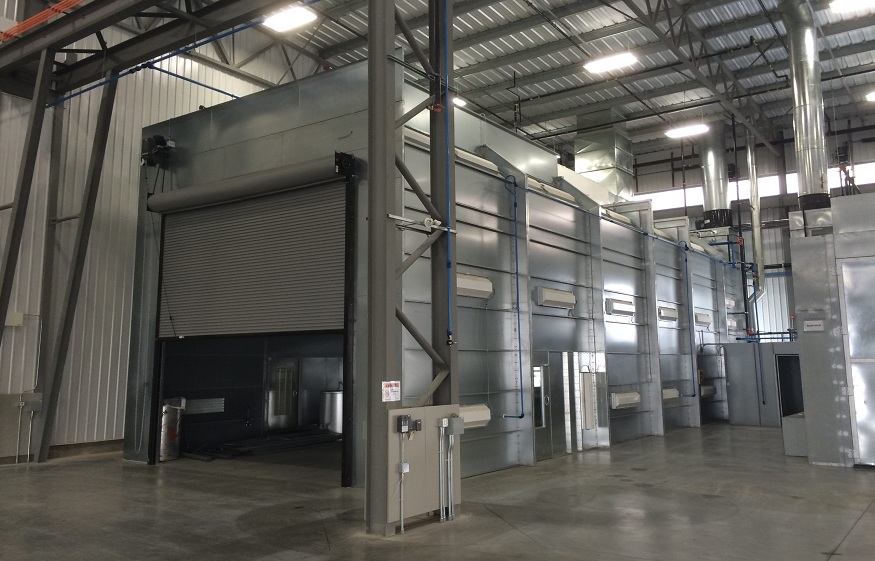Choosing the right industrial paint booth can feel a little like picking the perfect tool from a giant toolbox—you need one that fits just right. Semi-downdraft booths are a smart choice for many, but they’re not for everyone. Figuring out if they’re a good match comes down to how you paint, what you paint, and where you’re doing it.
Evaluating Production Scale and Airflow Precision Needs
The size of your production line matters more than you might think. A semi-downdraft industrial paint booth moves air in a specific way—it pulls air from the ceiling near the front of the booth and sends it out through the back near the floor. This setup works well for shops with moderate workloads, where a steady flow of jobs needs reliable but not hyper-precise airflow. It’s a big step up from open-air painting, offering cleaner finishes without needing a full downdraft system.
But if your production volume is massive or you’re spraying complex shapes that need perfectly even coverage, this booth type might fall short. The airflow isn’t quite as balanced from top to bottom as it is in a full downdraft setup. Still, for many small to mid-size operations, the airflow precision of a semi-downdraft booth is just enough to get the job done cleanly and consistently. It all depends on how much control your team needs to meet your daily production goals.
Will Semi-Downdraft Efficiency Match Your Finishing Standards?
Paint finish quality depends a lot on how smooth and steady your environment is. With a semi-downdraft industrial paint booth, you’ll get airflow that moves overspray down and away from the product—but not always evenly across every inch. For teams working with straightforward parts or surfaces that don’t require flawless gloss, this setup is a solid performer. It gives a clean workspace, reduces debris, and supports a smooth paint process.
However, if your standards are sky-high—like showroom-level automotive work or high-end metal finishing—you’ll want to think twice. Even small air variations in a semi-downdraft system can cause uneven curing or light surface texture. So the real question becomes: are you finishing parts for function, or for flawless appearance? Your quality expectations will shape whether this booth hits the mark or falls a bit short.
Comparing Budget Impact Versus Finish Quality Expectations
Money always comes into play, especially with big equipment like an industrial paint booth. Semi-downdraft booths are a great middle ground—they’re more affordable than downdraft versions but still offer real airflow control. For many shops trying to level up from open spray areas without blowing the budget, this design makes sense. You get better overspray control, faster cleanup, and a safer environment without the top-tier price tag.
But there’s always a trade-off. Lower cost usually means slightly lower performance. If your business relies on ultra-smooth finishes to keep customers happy, spending more upfront might make sense in the long run. On the other hand, if your jobs involve large volumes and basic finishes, a semi-downdraft booth can be the sweet spot—balancing budget and results without overdoing it.
Identifying Facility Space Constraints and Booth Placement Factors
Some industrial paint booth designs just won’t fit everywhere. One of the reasons semi-downdraft booths are so popular is because they’re more flexible when it comes to layout. They don’t need a deep pit or complicated airflow ducts under the floor. That means easier placement in buildings where space is tight or concrete cutting is off the table. Shops working in smaller facilities can usually find room for this setup with less hassle.
Still, you’ll want to think carefully about booth placement. Since the air enters from the top front and exits at the rear, you need clear paths for intake and exhaust. That affects not just where the booth goes, but what’s around it—walls, doors, and even nearby machinery. Good airflow depends on good planning. A semi-downdraft booth can fit in more places, but it still needs to breathe properly to work its best.
Analyzing Your Process for Ideal Contaminant Control Levels
Dust, overspray, and tiny particles are the enemies of clean finishes. The more control you have over them, the better your paint results. Semi-downdraft booths help keep particles from hanging around, thanks to their directional airflow. But they don’t trap contaminants as evenly as full downdraft systems. If your workflow involves delicate coatings or reactive materials, every speck matters—and your booth choice should reflect that.
For less-sensitive applications, though, semi-downdraft booths are a big step up from makeshift setups. They pull fumes and debris away from workers and surfaces, making the space safer and more consistent. The key is matching your product and paint type to the booth’s abilities. If your process can tolerate a little airflow variation, this booth will keep you ahead of common contaminant problems.
Assessing Regulatory Compliance Through Booth Design Selection
When it comes to safety and compliance, booth design plays a major role. Local and federal codes often have specific ventilation, filtration, and fire safety rules. A semi-downdraft industrial paint booth usually checks many of those boxes—especially with proper exhaust filters and fire suppression systems installed. It’s a practical choice for shops looking to meet codes without going overboard on infrastructure upgrades.
That said, every shop has different regulations to meet, depending on what’s being sprayed and how often. Some materials require higher-level containment or ventilation systems. Checking your local air quality guidelines and OSHA rules will help you decide if a semi-downdraft booth fits the bill. For many operations, it strikes the right balance between compliance and function—offering a safer, cleaner space without needing a full building overhaul.

